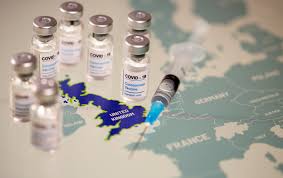COVID-19 Vaccine and Its Distribution to Various Geographies

COVID-19 pandemic has gravely affected the world economy. The research institutes, pharmaceutical companies, and healthcare organizations, together are working on the response, tracing the pandemic, advising on crucial interventions, and contributing to the distribution of the essential medical supplies to patients. Moreover, the healthcare personnel are parallelly engaged in the development and deployment of effective and safe vaccines. With the rollout of vaccines, millions of lives can be saved each year. Vaccines develop natural defenses, creating a natural immune system that recognizes and fights off the bacteria and viruses they target.
In a span of less than 12 months, post the beginning of the COVID-19 pandemic, there were several research institutes and pharmaceutical companies, started the development of vaccines that protect from SARS-CoV-2, the virus that causes COVID-19. The process for the development of a vaccine for the COVID-19 pandemic is much faster, compared to the other vaccine development process. Within a year, several pharmaceutical companies and research institutes have already announced the successful development of a vaccine that are being approved for use in various countries, including the US and India. Many vaccines against COVID-19 are being developed, and a few of them have already shown favorable results with 70%-95% efficacy in their pivotal Phase III trials. Various developed countries have been approved for COVID-19 developed by Pfizer/BioNTech.
Several institutions are maintaining websites and listing COVID-19 vaccines that are presently being developed. Some of these institutes have been mentioned below:
- The London School of Hygiene & Tropical Medicine Vaccine Tracker is updated weekly and reveals the present-day stage of each development of the COVID-19 vaccine.
- WHO Vaccine Tracker – It tracks the COVID-19 vaccines that are under development.
- Milken Institute Vaccine Tracker – It publishes and consistently updates a tracker of promising treatments and vaccines for COVID-19 that are under development.
- New York Times – It demonstrates brief summaries of each COVID-19 vaccine development.
In December 2020, the UK turn out to be the first country globally to approve the COVID-19 vaccine and began rolling out of the vaccine, initially with 800,000 doses in the first month. The priority for vaccination was given to older adults in care homes, healthcare workers, senior citizens aged 80 years and above. Since the COVID-19 vaccine is an RNA vaccine that needs to be kept at cold temperatures, below -70 °C, the initial vaccinations were carried out in hospitals. BioNTech, in collaboration with Pfizer, has started testing its BNT162 vaccine, initially in Germany and then in the USA. The final trial of this vaccine confirmed its efficacy with 94.0%, and the results were sent to regulators in Europe and the US for an emergency license. The vaccine has been created by Moderna in Massachusetts and funded by the National Institute of Allergy and Infectious Diseases (NIAID), a part of the US National Institutes of Health.
Several countries have begun to vaccinate critical care patients and front-line workers and post the rollout of several COVID-19 vaccines in December 2020. The groundbreaking technology of Moderna's Pfizer-BioNTech vaccines require considerably lower temperatures at -70˚C and -20˚C, respectively. However, the supply chain for these COVID-19 vaccines is a challenge for the emerging nations that lack existing refrigeration structures for vaccinations between 2 ˚C and 8˚C.
At present, there are over 50 COVID-19 vaccine candidates in trials across the globe. The WHO (World Health Organizations) collaborates with businesses, scientists, and global health organizations across the ACT Accelerator to pace the pandemic response. When an effective and safe vaccine is found, COVAX (led by GAVI, WHO, and CEPI) will enable the impartial access and distribution of these vaccines to safeguard people in all countries. The healthcare ministers globally are working towards rolling out an effective and safe vaccine; simultaneously, they continue with the essential public health actions to curb transmission of disease and reduce mortality.
The research, development, and distribution process of COVID-19 requires plenty of time, and it might be a big-budget for underdeveloped economies. Although the fair distribution of vaccines is still a heavy concern for world leaders, equitable access to the COVID-19 vaccines worldwide is challenging. It is expected that it will take years for most of the world's population to become vaccinated against COVID-19. Gavi, the Vaccine Alliance, is seeking to distribute two billion doses globally by the end of 2021. Researchers have developed distinct scenarios for vaccine distribution for the efficient distribution network, through which even hugely populated countries, such as Australia, will be able to achieve high vaccination rates in a couple of months.
Several countries have begun with the biggest vaccination campaign, with over 68.1 million doses in across 56 countries have been administered. Moreover, in an attempt to accelerate vaccinations after a rollout of the vaccine, in January 2021, the US government began encouraging states to commence immunizing all residents aged 65 years and above, along with those aged 16 years and above with certain medical conditions. The directive would open vaccinations up to over a third of the US population, more than the existing supply of vaccines could support. The US manages state allotments of Pfizer and BioNTech's vaccine, and Moderna's shot and is further planning to make more shots available to boost vaccinations. The federal government manages a centralized system to order, distribute, and trace COVID-19 vaccines, which are ordered through CDC (Centers for Disease Control and Prevention). Vaccination providers receive vaccines from the centralized distributor of CDC or directly from a vaccine manufacturer.
The Vaccine Readiness Assessment Tool (VIRAT) includes an excel template for countries to conclude and a cover note. The VIRAT is meant to be used by Ministries of Health, with assistance from WHO and UNICEF Country Offices. It presents a roadmap for countries to prepare for COVID-19 vaccine introduction and a coordinated framework for countries to self-monitor their readiness improvement against key milestones. Governments can use the VIRAT to identify the area where support may be needed. The cover note is a high-level introductory document that explains the tool's purpose and highlights the critical activities and technical areas that should be initiated.










